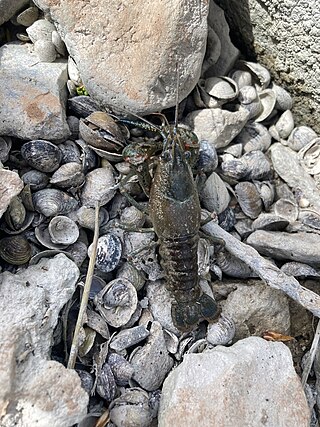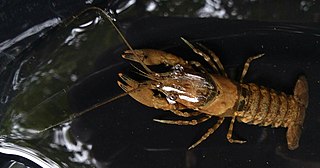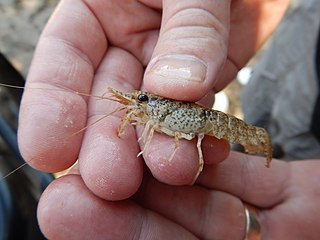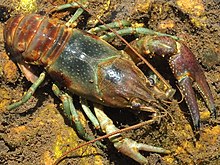
Crayfish are freshwater crustaceans belonging to the infraorder Astacidea, which also contains lobsters. Taxonomically, they are members of the superfamilies Astacoidea and Parastacoidea. They breathe through feather-like gills. Some species are found in brooks and streams, where fresh water is running, while others thrive in swamps, ditches, and paddy fields. Most crayfish cannot tolerate polluted water, although some species, such as Procambarus clarkii, are hardier. Crayfish feed on animals and plants, either living or decomposing, and detritus.

Orconectes is a genus of cave dwelling freshwater crayfish, endemic to suitable habitats in the eastern United States. Surface dwelling species, formerly categorised here, were moved to Faxonius in 2017.
Faxonius hathawayi blacki, the Calcasieu crayfish, is a sub-species of crayfish in the family Cambaridae. It is endemic to Louisiana. The common name refers to the Calcasieu River, near where the original specimens were found in Beauregard Parish, Louisiana.
Faxonius cooperi, the Flint River crayfish, is a species of crayfish in the family Cambaridae. It is endemic to Alabama and Tennessee in the United States. The common name refers to the Flint River, where the original specimens were found.

Faxonius deanae, the Conchas crayfish is a species of crayfish in the family Cambaridae. It is endemic to the United States. The common name refers to the Conchas Lake, where the original specimens were found.
Faxonius jonesi, the Sucarnoochee River crayfish, is a species of crayfish in the family Cambaridae. The common name refers to the Sucarnoochee River, near where the original specimens were found in Kemper County, Mississippi. It is endemic to Mississippi and Alabama in the United States.
Faxonius menae, the Mena crayfish, is a species of crayfish in the family Cambaridae. It is endemic to Oklahoma and Arkansas in the United States. The specific epithet and common name both refer to Mena, Arkansas, where the original specimens were found.

Faxonius shoupi, the Nashville crayfish, is a freshwater crustacean native to the Mill Creek Basin in Nashville, Tennessee. Prior to August 2017, the species was called Orconectes shoupi. Faxonius shoupi is protected under the Endangered Species Act (ESA) as an endangered species. However, the crayfish has recently been put up for delisting by the United States Fish and Wildlife Service.
Faxonius stannardi, the Little Wabash crayfish, is a species of crayfish in the family Cambaridae. It is endemic to Illinois. The common name refers to the Little Wabash River, where the original specimens were found.

Walter Faxon was an American ornithologist and carcinologist. He was born at Jamaica Plain, Massachusetts, where he grew up. He received three degrees from Harvard University. One of his greater ornithological achievements was demonstration that Brewster's warbler is a hybrid.

Faxonius limosus, synonym Orconectes limosus, is a species of crayfish in the family Cambaridae. It is native to the east coast of North America, from Quebec to the lower James River, Virginia, but has also been introduced to Europe. It is known commonly as the spinycheek crayfish or Kamberkrebs in German.

Faxonius virilis is a species of crayfish known as the virile crayfish, northern crayfish,eastern crayfish, and lesser known as the lake crayfish or common crawfish. Faxonius virilis was reclassified in August 2017, and the genus was changed from Orconectes to Faxonius. It is native to the central United States, east to tributaries of Lake Erie, Lake Ontario, Lake Champlain and the St. Lawrence River in New York and to much of Canada.

Faxonius immunis is a species of crayfish in the family Cambaridae. It is native to North America and it is an introduced species in Europe, where it lives along the Upper Rhine. Its common names include calico crayfish and papershell crayfish.
Faxonius alabamensis, the Alabama crayfish, is a species of freshwater crayfish that lives in Alabama, Mississippi and Tennessee.

Faxonius erichsonianus is a species in the family Cambaridae ("crayfishes"), in the order Decapoda. A common name for Faxonius erichsonianus is reticulate crayfish. Faxonius erichsonianus is found in the south eastern United States of America.

Faxonius is a genus of freshwater crayfish in the family Cambaridae. There are more than 90 described species in Faxonius. It includes the rusty crayfish, an invasive species in North America, and three species, F. virilis, F. immunis, and F. limosus, that are invasive to Europe.

Faxonius lancifer, the shrimp crayfish, is a species of crayfish in the family Cambaridae. It is widespread in the South-Eastern United States.
Faxonius alluvius is a species of Cambarid crayfish endemic to the state of Indiana.

Faxonius neglectus, a species of freshwater crayfish also known as the ringed crayfish, is native to Central North America, with two major disjunct areas of distribution in the Ozarks and around Nebraska. The species name, Faxonius neglectus, was previously Orconectes neglectus. Faxonius was declared its own genus in 2017 by Crandall & De Grave, as many previously thought Orconectes species were found to not reside in caves.


















